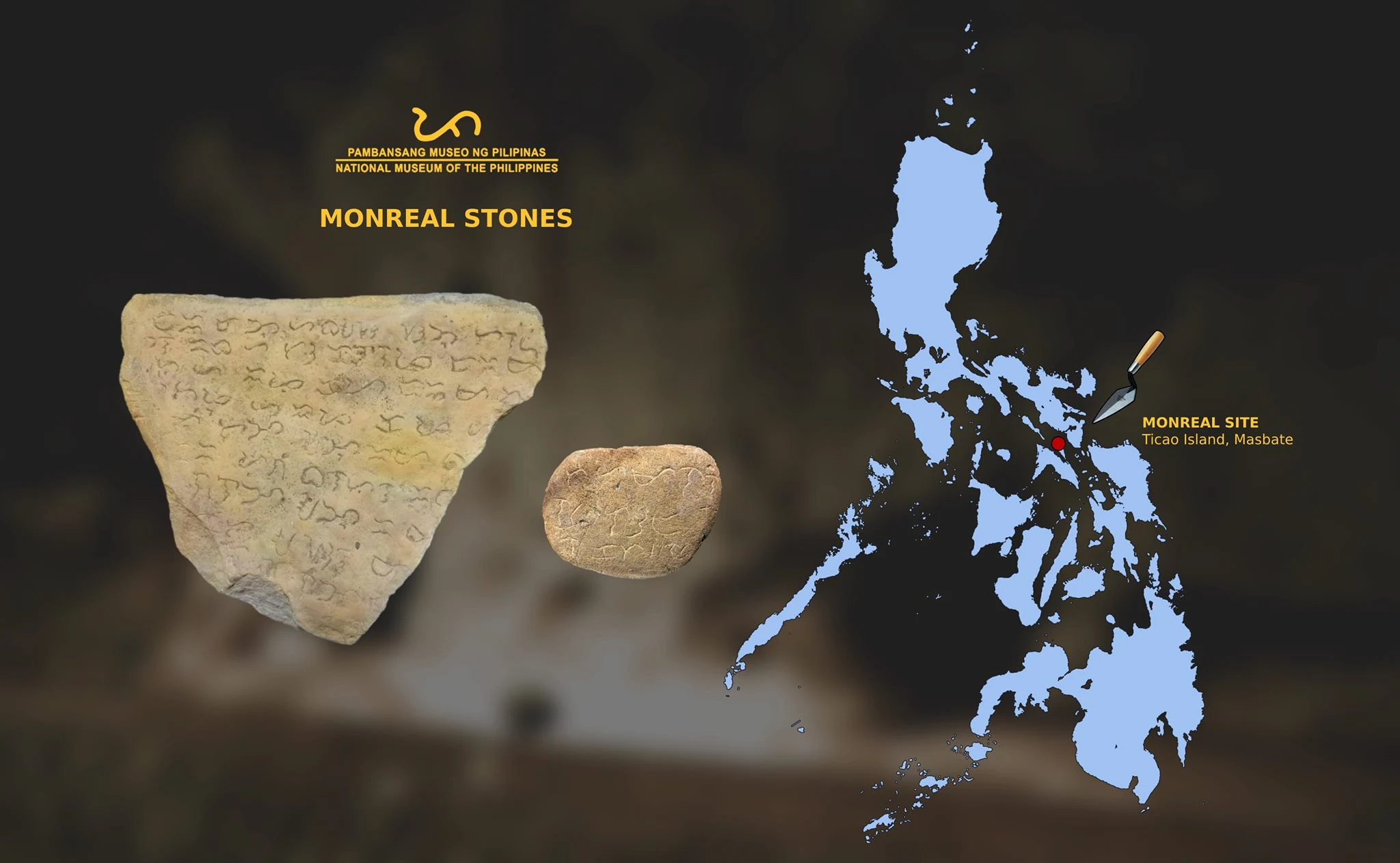Monreal Stones from Masbate | Interesting Artifact highlighting the Philippine's Distinctive Syllabic Writing Systems
Found in Ticao Island, Masbate, the Monreal Stones are a pair of irregularly shaped limestone tablets with engraved, horizontally patterned texts in ancient syllabic script. The pair is comprised of a large thick tablet in triangular form and a small thinner ovaloid one. The large stone tablet measures 57 cm long at the base, 44 cm wide at the apex, 11 cm thick, and weighs around 42 kg.
Both sides of the large stone are engraved with scripts, having 56 characters (7 lines) on one side and 84 characters (10 lines) on the other. It is missing its bottom and lateral portions, which could have been helpful in determining the actual size of the tablet and the message it contained.
 |
| The Monreal Stones, as exhibited at the Baybayin gallery of the National Museum of Anthropology. |
The small stone, in contrast, has only one side with engraved scripts, which features 16 characters. The smaller artifact is 20 cm long, 16 cm wide, and 6 cm thick.
The Monreal Stones came to the attention of the National Museum of the Philippines (NMP), when it was personally reported in June 2011 by Dr. Francisco Datar, a physical anthropologist and retired professor at the University of the Philippines-Diliman. Dr. Datar learned about the stones through a relative residing on Ticao Island, Masbate.
 |
| A close-up view of the Monreal Stones’ inscriptions. |
Like the Calatagan Ritual Pot, the stones’ nature of discovery, accidental and in an uncontrolled condition, partially clouds its archaeological context. They were found within the compound of Rizal Elementary School in the Municipality of Monreal, Ticao Island, as verified by interviews conducted with several teachers and students there.
Initially thought as an ordinary slab of stone, the large tablet was placed close to a classroom’s door and used as a mat to scrape off mud from the students’ footwear for years. In 2010, however, Virgie Espares Almodal, the new school principal, noticed what seems to be an unusual writing etched on the stone. Considering its possible historical and archaeological significance, Ms. Almodal had the stones cleaned to show the script, and temporarily exhibited at the school’s front.
To investigate the Monreal Stones’ authenticity and to gather data about it, fieldwork was conducted in June 2011 by the UP Ticao Masbate Anthropological Project Team, an interdisciplinary team formed by Dr. Datar. It was composed of Dr. Ricardo Nolasco (linguistics), Arnold Azurin (literature and Philippine studies), Dr. Ramon Guillermo (Philippine and Southeast Asian studies), Dr. May Anne Mata (applied mathematics), Myfel Joseph Paluga (history and anthropology), and Dr. Maricor Soriano (physics) and her 3D imaging team. They used the Phase Shift Profilometry, a type of 3D imaging method which allowed a thorough and accurate reading of the original engraved characters on the stones to transcribe its inscriptions. The application of 3D imaging was essential since the large stone’s scripts were “cleaned” by the Rizal Elementary School students using metal nails, which created new scratches along the original engravings’ lines.
Several other Filipino scholars such as Dr. Rolando Borrinaga, Dr. Quintin Oropilla, and Dr. Bonifacio Comandante have independently researched on the Monreal Stones to shed light on its context, reading, and authenticity. Mr. Wilfredo Ronquillo, then NMP Archaeology Division Chief, also did an archaeological inquiry of the site and the artifact itself in July 2011.
Though indefinite yet in terms of the Monreal Stones’ interpretation and translation, the preliminary transcription revealed interesting insights about its scripts: (1) The writings on each side of the stone tablets are not so different from one another; (2) The writings were done not just by one person; (3) The writings were possibly etched in different time periods; and (4) The writings have distinct features, which differ from the baybayin style in Doctrina Christiana, the late 16th century catechism book written by Fray Juan de Plasencia. Presently, the Monreal Stones’ precise date and interpretation or translation of its inscriptions remain inconclusive.
As an important archaeological evidence of the several ancient and extant syllabic scripts of the Philippines, the Monreal Stones were brought to the NMP in October 2011 for proper conservation and further analysis. They are presently exhibited at the Baybayin Gallery of the National Museum of Anthropology. While the NMP is still closed, we are upgrading this gallery to make it more understandable and accessible to more viewers once we are allowed to open to the public. In the meantime, please #keepsafe.
________________
Text and photos by Gregg Alfonso Abbang and poster by Timothy James Vitales / NMP Archaeology Division
Images courtesy of Dr. Ramon Guillermo | UP College of Arts and Letters and Dr. Maricor Soriano | National Institute of Physics, UP Diliman








No comments:
Got Something to Say? Thoughts? Additional Information?